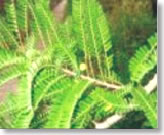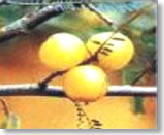
AMALAKI
Botanical Name: Phyallanthus emblica (EUPHORBIACEAE)
English Name: Indian Gooseberry
Hindi Name: Aonla, Amla

Introduction: Vedic literature did mention Amla as best among the fruits. It is one of the most commonly used medicinal plant in traditional medicine. It is considered as Vayahsthapan ( rejuvenation) and Rasayana (anti-oxidant) in Ayurvedic texts (C.S.SU. 25; C.S.Ci.1; Dha.Ni.). When administered orally, it is said to cure Vali (wrinkles of skin), Palita 9premature grey hair), Nilika& Vyanga (hyperpigmentation). It is also indicated for a wide range of cosmetic problems viz., Khalitya (baldness), Palitya (grey hair) & Darunaka( Dandruff) on external application.
Distribution: It is a large deciduous tree with greenish-grey bark. Widely available through out India and is also found under cultivation throughout tropical India.
Chemical Constituents:
- Root: ellagic acid, lupeol, oleanolic aldehyde etc.
- Bark: leucodelphinidin, procyanidin, tannin etc.
- Fruit: vitamin C, phyllemblin, linolic acid, indole acetic acid, ellagic acid, phyllemblic acid etc.
Parts Used: Fruit (mainly), bark, root
Properties: Sour, coolong, rejuvenant, tonic, good for heart, eye, skin & hair, appetizer etc.
Indications: Diabetes, eye diseases, hypercholkesterolemia, infections, vomiting, dyspepsia etc.
Dose: Fresh juice 10-20 mg; dried fruit powder 3-6g; bark/root powder 3-6g.
Therapeutic Uses:
- Grey hair: Emblica fruit, iron rust & shoe flower are made into paste applied externally.
- Dyspepsia: Stem bark powder is given with water.
Scientific Studies:
- Hair Tonic
- Anti-peptic ulcer activity
- Anti-diabetic property
- Hypolipidemic activity
- Ant-oxidant activity
Cultivation Technology: This cultivated widely through seedlongs. There are four improved varieties viz., Krishna (NA5), Amrit (NA6), Neelam (NA7) & Kanchan are developed by Narendradev University of Agricultural Technology, Ghaziabad, U.P. They are planted in the field at a distance of 8-10 ft ( in length & breadth).
Harvesting: The newer varieties are yielding fruits between 2-3 years time. The native varieties will take between 4-7 years for fruit yielding.







